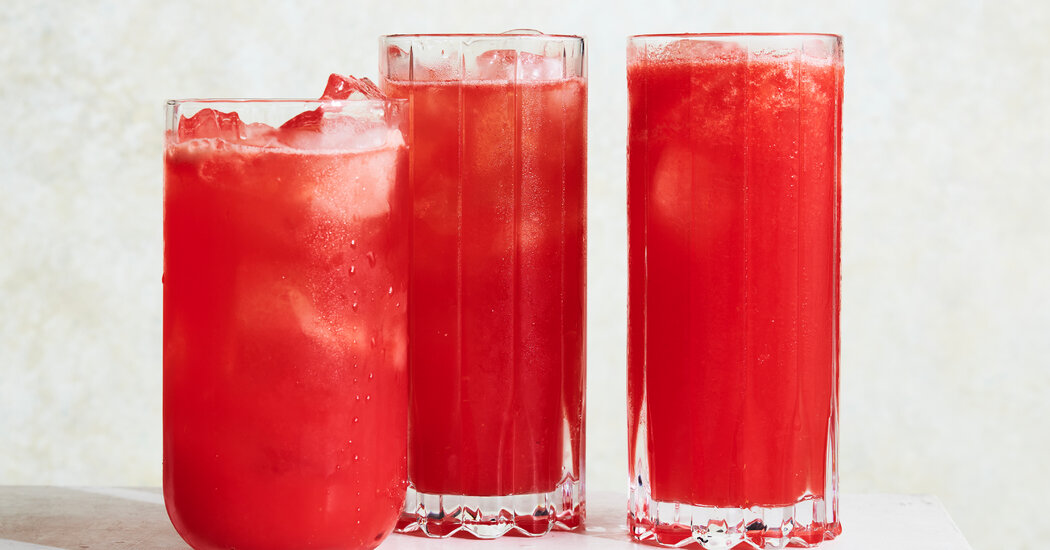
A cooler’s primary summertime function is written directly into the name: It cools. The style of drink — often a lower-in-alcohol combination of liqueur or fortified wine mixed with a carbonated beverage — is served long and tall over plenty of ice, with the promise of some relief from the heat.
Refreshing as it is to drink, a cooler is also a refreshingly easy cocktail to make.
The formula is loose and open to interpretation. A cooler is made with vermouth or sherry, port or gin, lengthened with soda water, or topped with dry tonic or fresh fruit juice. The ingredient list is often short and the method to the point: pour right into the glass, nary a shaker or mixing glass in sight.
“Coolers are the best drinks for this weather,” said Margot Lecarpentier, a founder of Combat, a bar in Paris. She recommends beginning your cooling happy hour with a simple and satisfying combination: a wine-based aperitif (such as a dry red or blanc vermouth), soda water and a slice of citrus. “It’s not as sweet as a spritz and works every time,” she said.
Once you’ve mastered this combination, invite experimentation. According to Ms. Lecarpentier, coolers provide an excellent entry point to cocktail making. “Mixology can be mysterious and scary,” she said. “But with coolers, it’s easy.”
There are plenty of ways to switch things up. Pour a flavored tonic. Swap in one citrus for another, or add a splash of cider vinegar. Try a few dashes of bitters, like classic Angostura, celery, chocolate or persimmon. Or add a rim: Ms. Lecarpentier suggests playing with salt, sugar or spices — such as Tajín, smoked pepper or sumac — depending on the drink.
Consider adding salt directly to your cooler to highlight its flavors or temper sweetness. A pinch of flaky sea salt, a dash of Worcestershire sauce or a splash of brine from cornichons or olives all work wonders to take a drink from fine to delightfully drinkable.
Even a final garnish can have a surprisingly strong impact. “You always have to think about the smell,” Ms. Lecarpentier said. “If you have a leaf of basil, it is so powerful at the nose you feel like you’re drinking it, but you’re just smelling it.” In a basil vermouth cooler, the fragrant herb is used not once but twice: first to infuse a bottle of dry vermouth and later as garnish.
You can also skip carbonation altogether and amplify a cocktail with juice. Ms. Lecarpentier often mixes fresh tomato, cucumber or pineapple juice into drinks; this watermelon-lime cooler combines fresh watermelon juice with bittersweet Lillet Rosé, gin, red bitter liqueur and lime juice.
For an aesthetically pleasing addition that is also functional, add slices of cucumber or citrus directly to the cocktail. A Porto cooler layers a bright display of lemon, lime and orange wheels around the inside of the glass. The longer the drink of white port, vermouth and tonic sits, the more intense the citrus flavor.
The summer heat can also slowly transform a cocktail built over ice. Ice from your own freezer rarely matches the quality of that in a professional bar, and so drinks mixed in the comfort of home can often dilute faster.
“The first sip isn’t going to taste like the last, “Ms. Lecarpentier said. “So I’m not scared of making drinks that are a little intense in the first sip because I know they’re going to evolve as you drink it.”
And, let’s face it, it is H-O-T outside. The cooler, in all its frigorific glory, offers icy relaxation. Refreshing to drink at every stage, the adaptable cooler should be considered this season’s long line of defense against the heat of late summer. You’re going to need it.
Recipes: Basil Vermouth Cooler | Watermelon-Lime Cooler | Porto Cooler


